Translating purpose into business reality requires more than you think, and the workforce has clear expectations
Introduction
Businesses in the UK and around the globe are finding it increasingly harder to maintain a strong competitive position and attract and retain talent today. Record-high inflation and a cost-of-living crisis,1 a rise in job vacancies and skills shortages,2 worsening social injustice and inequality3 and challenges related to climate change4 continue to have a huge impact on individuals and organisations alike. In response, companies are being expected, perhaps now more than ever, to show genuine commitment towards more than just maximising profits and to demonstrate purpose in their interactions with customers, employees, supply chain partners and the broader communities in which they operate.
Our definition of purpose is ‘an organisation’s explicit drive to create value beyond profit, specifically for our planet and the people on it.’ We believe that when embedded into the organisation’s strategy, culture and everyday operations, purpose indeed drives value for the organisation and its stakeholders. Yet while there’s evidence to suggest that organisations understand the importance of purpose given the growing emphasis on social action from investors and other stakeholders,5 we also note that organisations often struggle with the intangible nature of purpose. It may be challenging both to measure purpose and to embed purpose into core business operations – but failing to do so has costs. It risks alienating employees who want their organisation to show purpose, as well as customers who want to buy from a brand whose values align with their own. And, if purpose is merely spoken of and not lived, it may open the organisation up to allegations of purpose-washing or greenwashing.
About this survey
In June 2022, we surveyed a UK representative sample of over 4,000 employees across different industries and sectors to better understand their perspectives regarding the factors that should be part of an organisation’s purpose, how important purpose was in their decisions to join or leave an organisation and the extent to which external communications around purpose reflected the reality of their everyday work experiences. The analysis revealed how integral purpose is for employees and organisations alike, as well as several gaps that organisations need to address to create internal alignment and translate purpose into business reality.
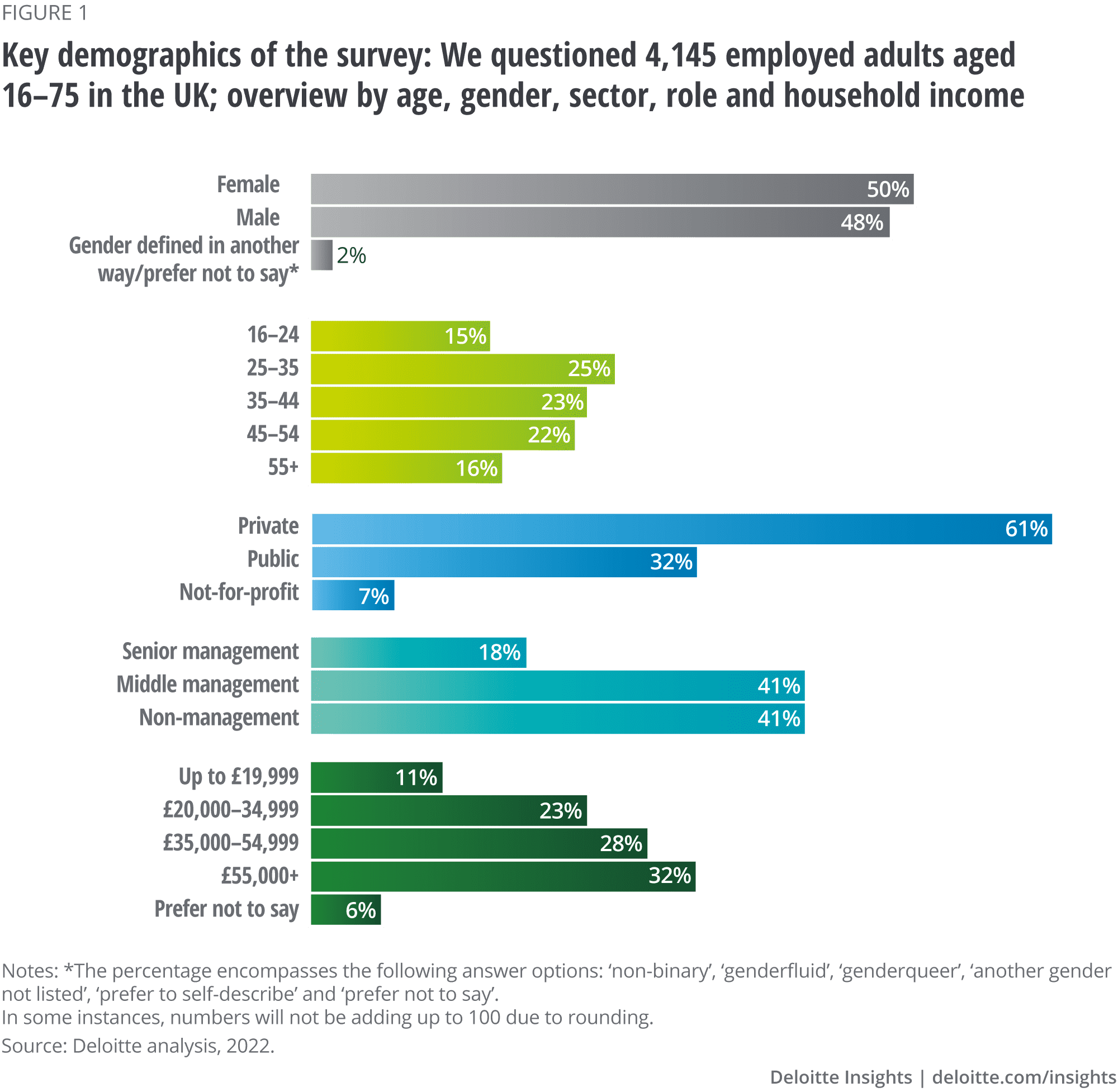
The Survey Findings
Five key purpose gaps, as perceived by your workforce
The perception/reality gap – purpose matters to employees, but only half see it mirrored in their workplace reality
Employees generally seem to have a good understanding of their employers’ purpose, with 84% of respondents reporting that they know at least a little about their organisation’s purpose, and nearly half (48%) saying they know a lot. In addition, respondents consider it important to work for an employer that provides meaningful work (84%), makes them feel proud of the organisation they work for (83%) and plays a role in creating a better future for the next generation (80%). These responses clearly demonstrate how relevant purpose is to this stakeholder group. But there are some notable gaps between how purpose is projected externally and the way it is embedded within the organisation itself. While roughly two-thirds of employees in our survey believe that their organisation has a clearly defined purpose and that it is generally perceived by the public to be true to its purpose, only half (52%) agreed that external purpose communications are consistent with internal practices, such as leadership behaviours or the workplace culture. Moreover, 41% agreed that their organisation has purpose in some areas, but that these are not connected to a common goal, and nearly one in three respondents stated that their organisation does not take any action to pursue its stated purpose (Figure 2).
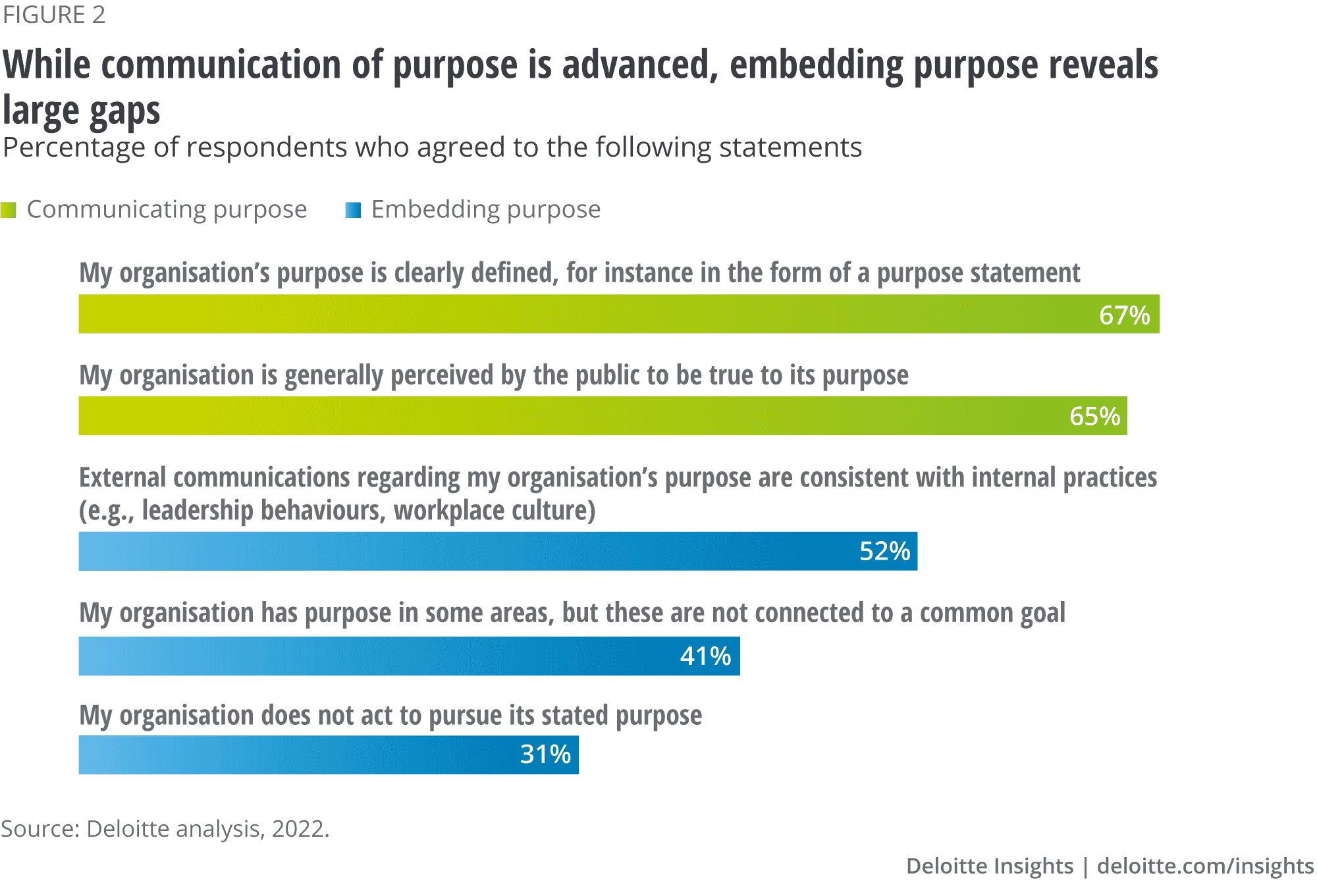
These findings highlight the disconnect between external communications around purpose and embedding purpose into internal practices. Yet employers who fail to demonstrate consistency between their stated corporate purpose and everyday employee activities are likely to miss out on key outcomes such as employee engagement and organisational growth,6 and risk negative consequences such as allegations of purpose-washing. In fact, our data shows that employees who experience internal alignment between purpose, culture and leadership behaviours, and who understand how their day-to-day work relates to their organisation’s purpose ambitions show higher levels of motivation and trust, and a lower desire to quit their job. In addition, they are also more likely to recommend their employer to others (figure 3). In the context of the Great Resignation7 and reports that the pandemic has prompted people to seek jobs that bring more meaning to their lives,8 these findings demonstrate how purpose can help attract and retain talent.
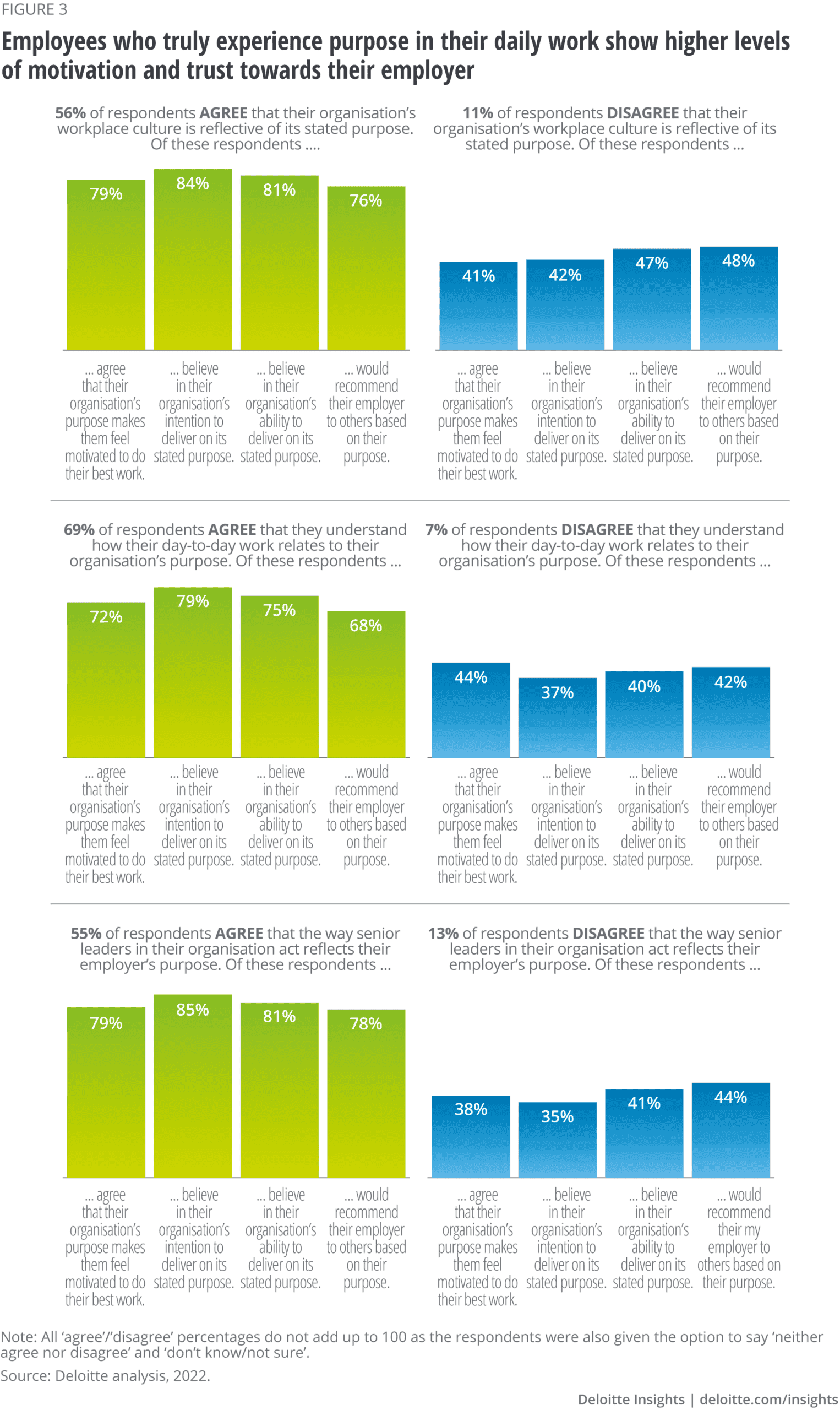
The integrity gap – demonstrating purpose starts with genuine concern for workers’ well-being
While our data showed the importance of several purpose-related drivers that help organisations create value for different stakeholders, it should be noted that employees seem to have a stronger affinity for issues that impact them directly, particularly salary, benefits and professional development.We feel this reflects the conditions prevalent in the current labour market, including the cost-of-living crisis9 and skills shortages.10 Eighty-three per cent of employees in our study say that, when it comes to acting in a purpose-driven manner, organisations should first and foremost provide a salary and benefits package aligned with the cost of living and support employees on their professional development journeys.
Yet this is not to say that broader societal issues (outside the company) are unimportant. In fact, over 74% of employees believe factors such as organisations reducing their environmental impact, improving the communities where they operate and adopting sustainable supply chain practices should indeed be part of an organisation’s purpose.
These findings have two main implications. First, purpose preferences change over time in response to external market factors, with the cost-of-living crisis currently being at the forefront of employees’ concerns. This seems to be in line with the recent Deloitte Gen Z and Millennial Survey,11 which also showed that the cost of living was the greatest concern for these two generations, taking precedence over factors such as climate change and health-related concerns for the first time. Second, purpose needs to be personal and adaptive. If employees are to trust the organisations they work for, employers need to show genuine concern for the well-being of their workforce, including their financial well-being, and respond to external market challenges affecting different stakeholders.
The attraction/retention gap – purpose determines why workers stay or leave
As mentioned previously, purpose can act as a key factor for attracting and retaining talent, helping organisations navigate the tight labour market, one of the major challenges on the C-suite agenda today.12 Specifically, 62% of respondents in our study said that they considered their organisation’s purpose when they joined, and 47% reported that they had left an organisation for purpose-related reasons. In fact, purpose seemed to be especially important for Gen Z and millennials – those aged under 44 years old – who were much more likely to choose and switch jobs for reasons related to purpose compared to older generations (figure 4). This is again consistent with Deloitte’s 2022 Gen Z and Millennial Survey,13 which similarly showed that two in five respondents have rejected a job or assignment because it did not align with their values. As these two generations already represent the majority of today’s workforce and are moving into roles with greater responsibility, such findings suggest that purpose may become all the more important to organisations in coming years.
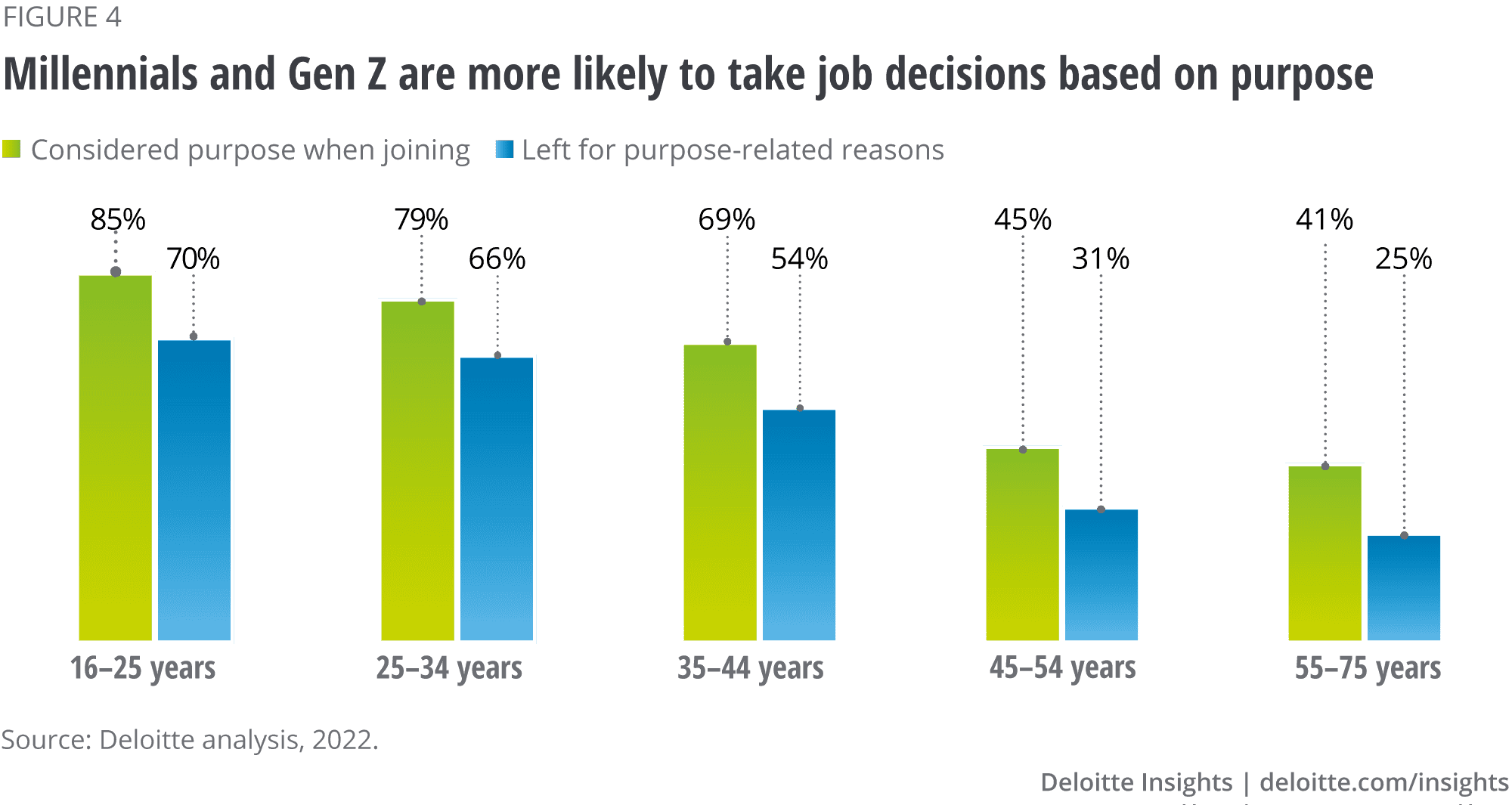
Furthermore, our study found that purpose is as important as salary for 36% of respondents in their decision to join an organisation. While the figure is higher for those in non-profit (50%) and public sector organisations (40%), one in three private sector employees also considered purpose to be just as important as their salary and benefits package. What this shows is that businesses must prioritise and embed purpose in their talent strategies and people experience, especially in the context of the Great Resignation. Previously, having a clear purpose was seen as the focus of public and non-profit organisations. Now, our data shows that the private sector is catching up and that employees are expecting a lot more from businesses when it comes to demonstrating purpose.
The transparency gap – purpose is not seen as being in conflict with profit, but transparency about both is needed
A common misconception is that purpose and profits are incompatible. Our survey respondents believe they can complement one another. For instance, 68% of private sector employees in our study acknowledge that maximising profits should be part of an organisation’s purpose, in addition to actions taken to improve the employee experience and drive social and environmental change. Similarly, in the public and non-profit sector, employees think organisations should be responsible in their use of public funding, with 80% and 76% of respondents respectively saying that organisations need to demonstrate efficient use of taxpayer money as part of their purpose strategy.
Still, the key is for organisations to show that they stand for something beyond profit and are concerned about how profits are generated and invested. Impact reporting around purpose could be an important missing link towards improving transparency and instilling further trust. Indeed, in our study, only half of respondents agreed that their organisation has an appropriate framework in place to measure its social impact and be accountable, and less than half (48%) reported this in relation to environmental impact. Furthermore, employees need to see how their efforts are connected to goals that are broader than meeting financial targets. But in our research, only 64% of employees agreed that their role creates value beyond profit. This points to the importance of defining purpose as part of the business strategy and involving employees in the process.
The role-model gap – only half the workforce sees leadership behaviour as being in line with purpose
A final theme that emerged from the data concerns the role of senior leaders in embedding purpose, and the gaps between employees’ expectations of leaders and what they experience on a day-to-day basis. Specifically, while more than 80% of respondents say it is important for senior leaders to behave in line with their organisation’s purpose and to demonstrate purpose in their work, only 55% agreed that their senior leaders do so. Senior leaders seem to agree that they need to take an active role and, compared to middle managers and non-managerial employees, were more likely to say that their behaviours should reflect their organisation’s purpose. In addition, they were more likely to: cite purpose in their decision to join or leave an organisation; agree that their organisation’s purpose is clearly defined; and trust their organisation’s ability and intent to deliver on the stated purpose (figure 5).
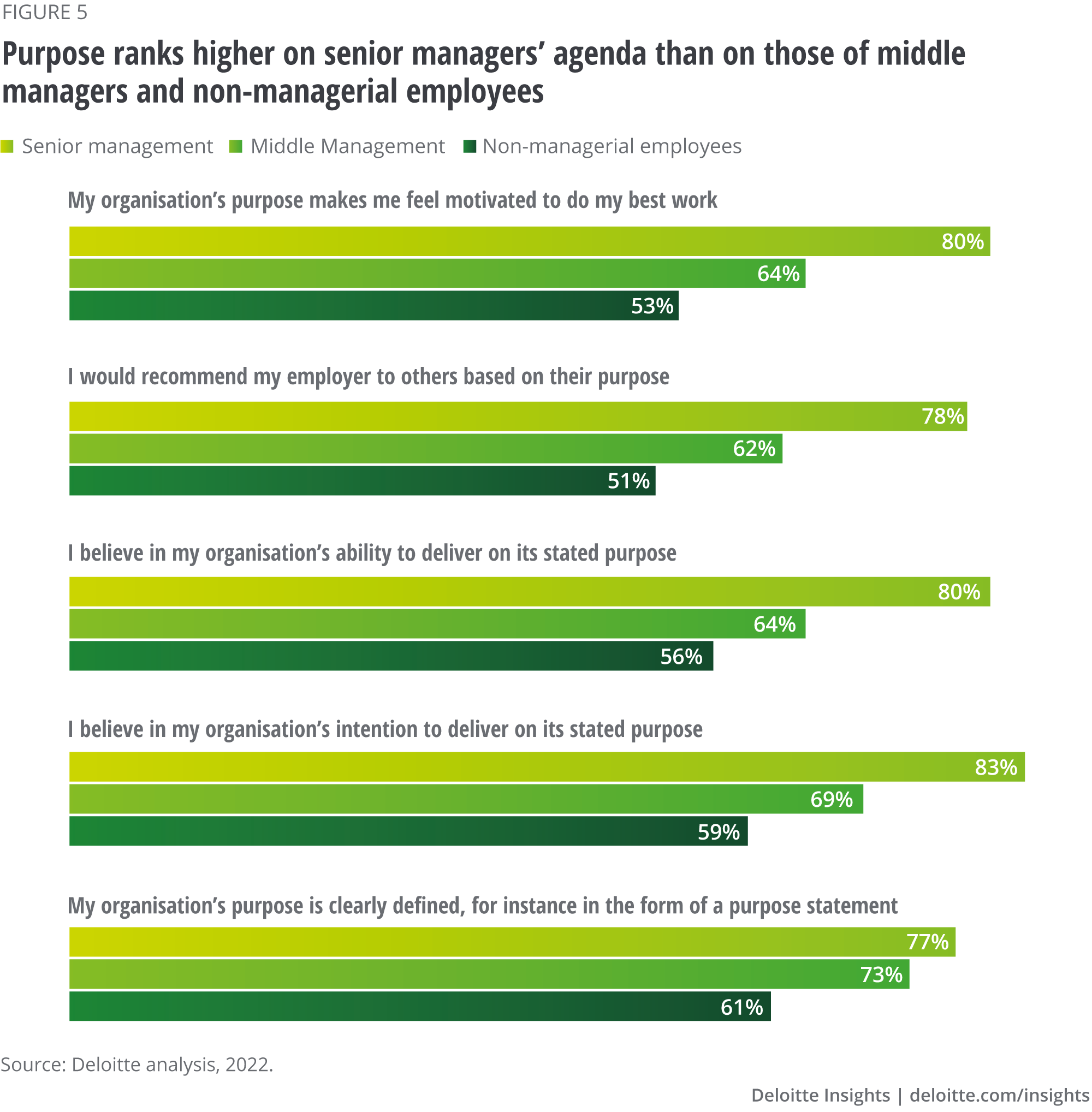
This may indicate that senior leaders have more knowledge of organisational strategies to support purpose-related activities as they may indeed be closer to strategic decision-making around purpose. But it also suggests a need for greater transparency, as well as making sure that purpose has been translated from high-level strategic goals into the practical, operational objectives of middle management and non-managerial employees. In addition, further implementing appropriate measures to ensure accountability may be needed. Recent Deloitte analysis suggests that while the vast majority of C-suite leaders perceive their organisations to have a clear and well-defined purpose strategy, 22% indicated that the company does not prioritise the collection and reporting of purpose-related data.14 In addition, only one in three reported that their performance is linked to the achievement of purpose-related objectives, which could explain the disconnect between leaders’ understanding of the importance of purpose and their efforts to demonstrate purpose in their day-to-day work.
The Lessons
What do the findings of the survey suggest that organisations should do? Below we set out our recommendations.
Lip service is not enough
First, while having a clear purpose statement is one of the initial steps in defining what the organisation stands for, it is critical that employers go beyond lip service and properly embed purpose into every aspect of the organisation – from strategy and decision-making, culture and behaviour, to brand, products and stakeholder relationships. This will ensure internal consistency that builds trust with employees, customers and the general public. It will also create opportunities for meaningful work and help employees see how their everyday actions can directly impact the different stakeholder groups they interact with. We suggest that purpose needs dedicated focus at the C-suite level, where the involvement of senior leadership can help ensure that purpose is given sufficient consideration across all business areas. Going one step further, this translates into both senior leaders and line managers having a key part to play in embedding purpose and making it real for employees in their everyday roles.
Recognise that purpose is not static and starts with your employees
A second lesson we derive is that purpose is not static – it should reflect a commitment towards addressing the major challenges affecting society at a given time. Recently, this could be seen in the example of numerous companies responding to the Russia-Ukraine conflict – either by suspending their operations in Russia, matching employee donations or providing financial assistance to displaced Ukrainian citizens.
In addition, we would argue that purpose needs to be both tangible and specific to the individual, with employees expecting organisations to show genuine concern for their well-being as well as embed purpose into their everyday activities. Ultimately, this may point towards the need to translate abstract environmental (e.g., net-zero) and social impact goals (e.g., improved diversity) into clear, measurable actions that employees at all levels see reflected in their own roles.
Emphasise purpose in recruitment, and maintain it with your long-standing staff too
Organisations across all sectors can bring purpose to life, so as to become an employer of choice. This can be done at all stages of the recruitment cycle – attraction, selection and onboarding – by clearly showcasing initiatives and success stories in corporate communications and via social media, discussing purpose-related initiatives and impact during job interviews, showing concrete examples of how individual roles contribute to the organisation’s overall purpose and by embedding purpose into job descriptions and briefs. In other words, it is imperative that purpose is evident and feels part of the organisation’s DNA from the moment an employee applies to join the organisation.
A two-way purpose communication then needs to be followed by authentic action. Employees should be empowered to have a say in identifying their organisation’s purpose and be given an opportunity to address important societal problems through their work.15 Indeed most respondents in our study consider it important to be involved in defining their organisation’s purpose (79%) and to be supported in demonstrating said purpose in their everyday activities (82%). Therefore, purpose communications shouldn’t be one-way. Instead, there should be a two-way dialogue that engages employees as well as other stakeholders in delivering purpose-related goals. By providing opportunities for greater involvement around purpose, organisations can gain an understanding of the societal issues that are foremost in the minds of their workforce and how these evolve over time. Employees can further recognise the meaning and impact of their work, and both employees and employers can unite towards achieving shared objectives.
Adopt a ‘profit with purpose’ strategy
While there’s no denying that profits are important, organisations need to consider how profits are generated, and whether value for society and the environment is created at the same time. If organisations adopt a ‘profit with purpose’ strategy, they can pursue financial gain at the same time as – and in many cases as a result of – delivering value to customers, communities and the public, and thus, truly differentiate themselves from organisations whose purpose goals are just an afterthought. In addition, adopting an appropriate framework to measure the impact of purpose may be particularly powerful, along with aligning core products and services with the organisation’s purpose goals. What is evident is that purpose cannot be separated from business strategy, and that profits can indeed be driven by the organisation’s societal initiatives.16
Close the purpose gap in leadership behaviour
To close the gap between purpose and leadership behaviours and help leaders genuinely act with purpose, being able to measure the value that purpose brings to different functions in the organisation is key. Further, purpose needs to be embedded into the core operations of the business – into roles and responsibilities as well as performance goals and how these are assessed and rewarded.17 More frequent communication at the team level and highlighting real-life stories to humanise what could otherwise be seen as a rather distant corporate message can also further increase transparency and reassure staff that leaders are indeed committed towards achieving societal impact. In addition, greater collaboration between senior leaders in different functions is needed to ensure that purpose relates to the wider strategic goals of the organisation – rather than being pursued in silos.
Conclusion: Stand Out Through Purpose
As macroeconomic challenges besiege individuals, organisations and societies as a whole, purpose can make organisations stand out. It can support organisations in their pursuit of talent and differentiate them from their competitors by highlighting the value they bring to customers, investors, regulators, local communities and the broader society.
Consistency between the externally facing purpose-led brand and the internal employee experience of purpose, however, is critical, and companies need to ensure that they effectively integrate purpose and draw on the workforce’s ideas in their business strategy. Adopting a more dynamic approach to managing purpose and having appropriate mechanisms for increased transparency and accountability may help organisations deliver on their purpose ambitions and shield them from accusations of purpose-washing. In addition, translating purpose into the operations of the business and involving both employees and senior leaders in embedding purpose can create a greater sense of ownership and employee loyalty. In short, purpose is not a cost for businesses. The most successful businesses of the future, those most appreciated by workers and consumers alike, will be those who deliver profit with purpose.
- Larry Elliott, “UK inflation hits fresh 40-year high of 9.4% and ‘could hit 12% in October,’” The Guardian, 20 July 2022. View in Article
- BBC News, “Job vacancies outpace unemployment for first time,” 17 May 2022; Deloitte Insights, How global labor markets are recovering from COVID-19, accessed 21 September 2022. View in Article
- Social Mobility Commission, “Most people believe inequality has increased due to the pandemic,” press release, Gov.uk, 11 March 2021.View in Article
- Justin Rowlatt, “UK heatwave: Why is it so hot?,” BBC News, 19 July 2022. View in Article
- Deloitte, “Deloitte: Corporate purpose tops C-suite priorities, but accountability and collaboration present challenges, press release, 2 February 2022; Tracy Brower, “The power of purpose and why it matters now,” Forbes, 22 August 2021. View in Article
- Kathy Miller Perkins, “Three best practices for embedding purpose and values into culture,” Forbes, 19 February 2020. View in Article
- Steven Hatfield et al., From Great Resignation to Great Reimagination, Deloitte, accessed 21 September 2022.View in Article
- Naina Dhingra et al., “Help your employees find purpose—or watch them leave,” McKinsey, 5 April 2021. View in Article
- Michael Buchanan, Eleanor Lawrie and Wesley Stephenson, “Cost of living: Why are things so hard for so many people?,” BBC News, 13 July 2022. View in Article
- Deedee Doke, “Skills shortages could cost UK economy £30bn a year,” Recruiter, 18 July 2022. View in Article
- Deloitte, Striving for balance, advocating for change, accessed 21 September 2022. View in Article
- Deloitte, “Summer 2022 Fortune/Deloitte CEO Survey,” accessed 21 September 2022. View in Article
- Deloitte, Striving for balance, advocating for change. View in Article
- Deloitte, “C-suite insights: How purpose delivers value,” accessed 21 September 2022. View in Article
- Deloitte, Striving for balance, advocating for change. View in Article
- Caroline Castrillon, “Why purpose is the new competitive advantage,” Forbes, 28 April 2019. View in Article
- Deloitte, “C-suite insights: How purpose delivers value.” View in Article
The authors would like to thank Rachel Charlton, Natalie Hallis Jani, Gethin Hine, Richard Horton, Helen Longfils, Ashley McKeever, Laura Parsons, Tim Rathbone, Laurie Rutter, Ram Krishna Sahu and Sara Sikora for their contributions to this article.
The article was first published here.
Photo by Mark Fletcher-Brown on Unsplash.

 5.0
5.0 





















